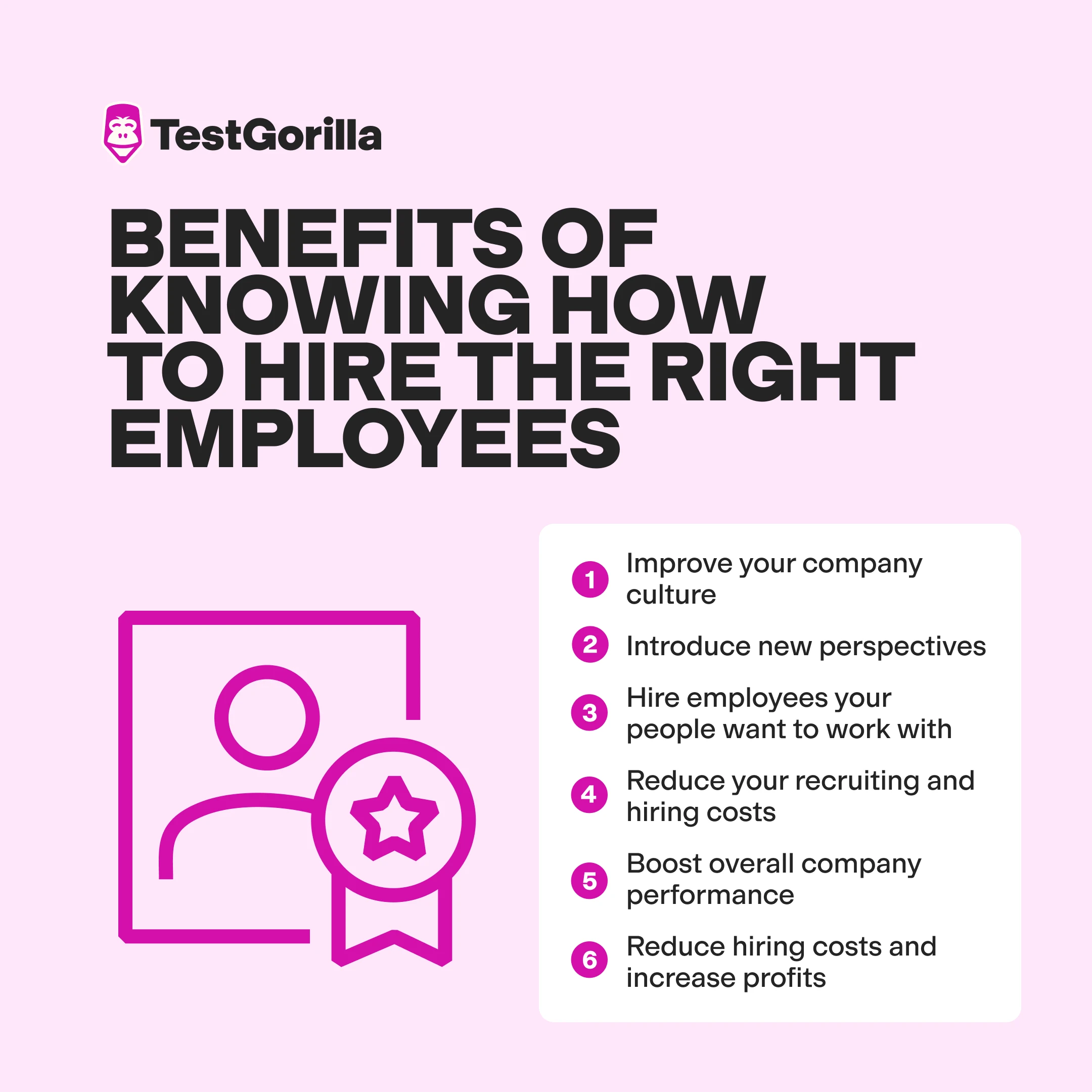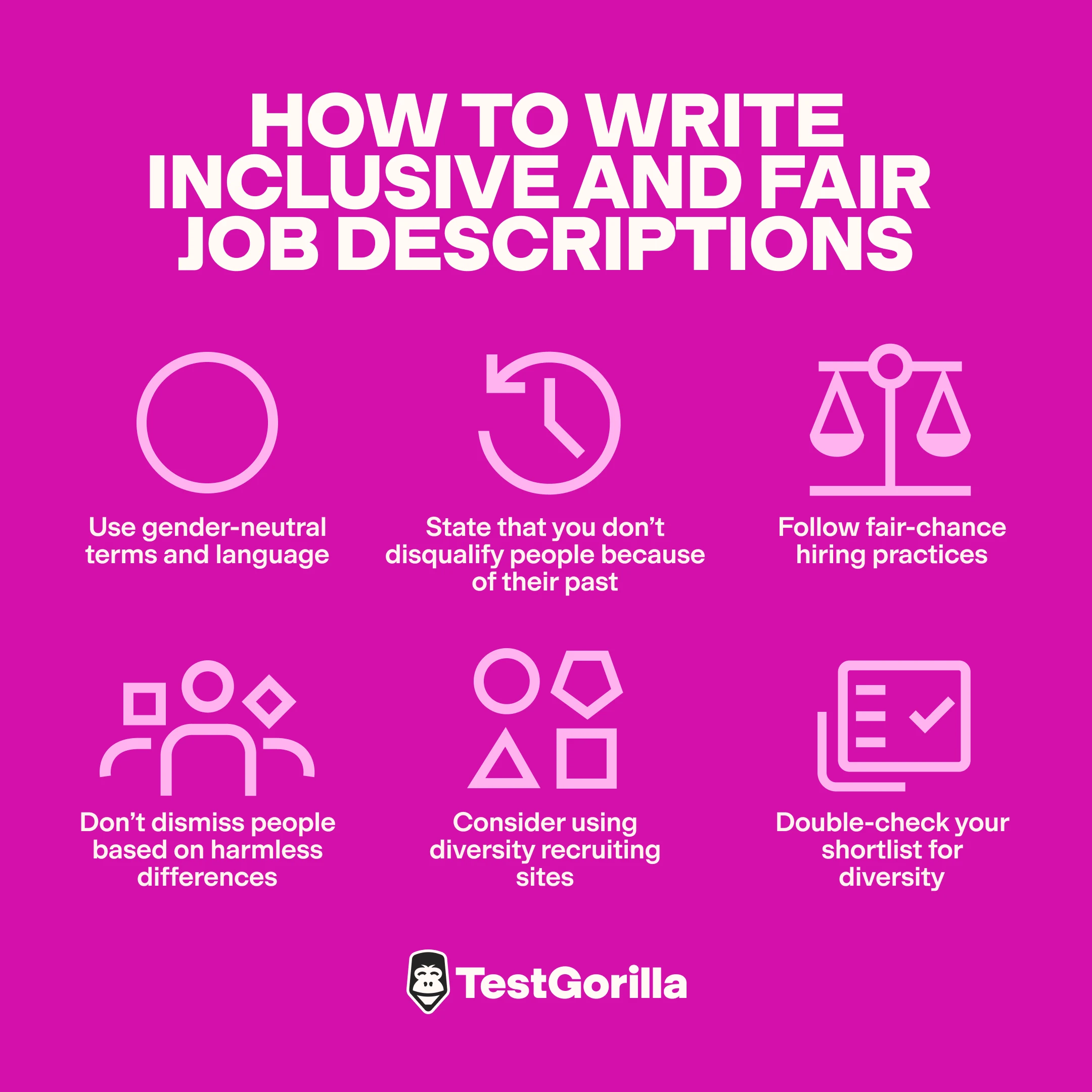How to hire the right person: Leverage this strategy and increase retention
Hire the right person with objective skills testing
Knowing how to hire the right person for the job is a fundamental HR skill that involves evaluating a candidate’s hard and soft skills, personality type, alignment with your organizational goals, and growth potential.
With huge numbers of candidates applying for each role, this is no mean feat, and traditional hiring methods like resume evaluation are no longer effective.
In this article, we discuss the importance of hiring the right employee and show you how to hire the right people using skills-based hiring methods.
Table of contents
- What do we mean by hiring the right people?
- The importance of hiring the right employee
- The benefits of hiring the right people
- 7 best practices on how to hire great employees and boost retention
- 3 examples of companies succeeding with hiring the right candidates as a talent retention strategy
- Sign up for a demo with TestGorilla to find out how to hire the right person
- How to hire the right person FAQs
What do we mean by hiring the right people?
Hiring the right people means drafting people who can successfully do their job. They have the essential skills and attributes crucial to the job opening, and they can blend in with the existing team dynamics.
Instead of letting personal biases affect your hiring decision, you should use talent assessments to assess candidates’ skills and personality types and understand how a prospect can fit within your team and organization.
By assessing these aspects, you make more accurate hires, improve the employee experience, and reduce employee turnover rates.
The importance of hiring the right employee
The cost of a bad hire can be debilitating to both entrepreneurs and small businesses. You’ve spent all that time on advertising and hiring, onboarding and training, potentially redoing the work that wasn’t done right – and then you have to sing it all again from the top if it doesn’t work out.
But how about when things do work out? Knowing how to hire the right employees helps you:
Improve your company culture: It’s important to hire people who embody company values and model the right behavior, such as healthy boundaries at work.
Introduce new perspectives: Avoid getting stuck in an echo chamber by bringing in a person who’s not exactly like the rest of the team.
Hire employees your people want to work with: Make collaboration and communication easy by hiring open, positive, respectful, and empathetic people.
Reduce your recruiting and hiring costs: Spend less on new job postings, the interview process, onboarding costs, and the headache of doing it again because the person wasn’t right for the role.
Boost overall company performance: Have a team of competent and motivated individuals who work like a well-oiled machine and produce excellent results.
Reduce hiring costs and increase profits: Making the right hire helps you decrease the costs associated with bad hires, onboarding, and doing double work. Furthermore, it helps you improve performance and deliverables, leading to happier clients, more work, and higher profits.
The best insights on HR and recruitment, delivered to your inbox.
Biweekly updates. No spam. Unsubscribe any time.
The benefits of hiring the right people
We’ve covered the importance of hiring the right employee for a role. But what tangible benefits can finding the right hire bring to your organization? Here are four:
1. How to hire the right person to increase retention
Hiring the right people does more than fill your open positions – it’s a way to keep your team together in the long run.
According to our State of Skills-Based Hiring 2023 report, 89% of companies found that using skills-based hiring improved employee retention rates.
Hiring the right people from the start saves the company from the financial hit of repeating the recruitment, onboarding, and training processes.
2. Increases satisfaction
When employees have the required skills, tasks feel more manageable, challenges become exciting, and job satisfaction soars.
Skills-based hires are better equipped to meet the specific demands of their positions. This alignment reduces stress and frustration, prevents employee burnout, and supports mental health in the workplace.
As a result, employees enjoy their work and find fulfillment in their contributions. In fact, the State of Skills-Based Hiring 2023 report revealed that 38% of skills-based hires report feeling happy in their roles, compared with 28% of work experience-based hires.
3. Boosts productivity and performance
Hiring the right people for the right roles helps improve workplace productivity and performance. They bring a level of efficiency that affects the whole team and do tasks well.
When the right people are on your team, their dedication inspires others to improve. This creates a positive cycle where team members strive for their best, collectively lifting the entire team’s performance. As a result, your company is more likely to reach and exceed its goals.
4. Reduces costs
Why does a bad hire cost the company so much?
Hiring the wrong fit for the job affects:
Productivity
Team morale
Client relationships
Company culture
Brand image
When that happens, the organization should invest in upskilling the new employee, retraining, correcting errors, and managing performance issues.
If it results in voluntary turnover, companies must repeat the process of finding, interviewing, and onboarding new people, which could lead to considerable expenses.
7 best practices on how to hire great employees and boost retention
When it comes to recruitment and selection, hiring the right person is the ultimate goal, and we’ve seen that finding the right hire brings many long-term benefits to your business.
Here are the best practices you should be aware of to teach your hiring managers how to hire great employees every time.
1. Write inclusive and fair job descriptions
Your job descriptions might not be as inclusive as you thought if you
Write “he/she” instead of a neutral “they” when referring to candidates
Use masculine, youthful terms like “ninja,” “wizard,” or “superstar” that seem harmless but discourage other genders and older workers from applying
Exclude candidates with a criminal record across the board
Require degrees for roles that don’t need them
Unless you make it clear that you welcome the best candidates of all genders, sexual orientations, neurotypes, religions, and various life experiences, you might miss out on great talent.
For example, companies that include people with criminal records experience significant benefits, including better performance and productivity.
To embrace inclusive hiring:
Use gender-neutral language
State that you don’t disqualify people because of their past unless it’s strictly necessary for the role
Follow fair-chance hiring practices
Don’t dismiss people based on harmless differences, like avoiding eye contact if they’re applying for a role where it’s irrelevant
Double-check your shortlist for diversity – for example, if all your potential hires have the same background and education, it could be a sign of interviewer bias
2. Take your time
Many bad hires result from hiring managers and recruiters rushing to fill an empty role.
When you need to hire the right person urgently, you can only take so many precautions.
That’s why you need to regularly consider your recruiting process and skills gaps before they become an emergency.
First, you should build and nurture a talent pool to always have high-quality candidates available. Don’t miss out on silver medalists and passive candidates because they weren’t right for the role this time. You might need them in the future.
You should also consider proactive recruitment strategies, such as identifying, sourcing, and recruiting candidates for roles before you need them.
To do this, you need to assess which skills are missing in your workforce, which brings us to our next point.
3. Perform a skills gap analysis
You need to perform a skills gap analysis to discover which roles and skills your company requires. This strategic approach identifies the difference between current employee skills and those crucial for organizational success.
Identifying skills gaps minimizes hiring errors, streamlines the selection, and boosts the chances of finding the ideal candidate who fits the outlined job specifications.
For example, a company looking for a good product marketing manager can use a skills gap analysis to identify crucial competencies needed for the role.
The results show that current project managers lack market analysis and stakeholder communication skills.
So, the organization uses a Product Marketing Management test to vet candidates and assess their market analysis and stakeholder communication abilities with questions like this:
The precise fit between skills and job expectations fosters a positive work environment where employees feel adequately supported and understood, which helps reduce attrition rates.
Hire the right person with the skills you need.
Use our objective skills test to identify candidates with the skills you need to go the distance
4. Conduct structured interviews
Structured interviews involve asking job candidates a consistent set of predetermined questions with clear criteria to assess the quality of their responses.
Asking all candidates the same interview questions in the same order is:
Fairer for candidates because they are given the same opportunity to succeed
Quicker and easier for hiring managers to compare candidates’ performance
More effective because job seekers are only tested on relevant skills
Structured interviews ensure a fair and standardized evaluation, minimizing subjectivity and discrimination.
They’re not time-consuming and help employers gain valuable insights into potential candidates’ capabilities, contributing to a more accurate prediction of their job performance.
5. Use a diversity of job boards to promote inclusive hiring
If you want to hire the right people, your talent acquisition efforts should focus on reaching more candidates with an inclusive hiring strategy.
To foster an inclusive culture, explore specialized job boards tailored to specific demographics, such as disabled workers or women in tech. Consider using diversity recruiting sites like DiversityWorking, Advancing Women, and RecruitDisability.
You can also use unconventional channels, including:
Industry-specific forums like LinkedIn
Social media groups
Platforms focused on emerging trends
Engaging with niche communities increases visibility and facilitates connections with candidates passionate about specific interests.
These methods improve the chances of reaching a diverse pool of qualified candidates and contribute to a more inclusive hiring process.
You can also broaden the talent pool by offering flexible work arrangements. They enable you to reach more potential employees, such as those looking for remote or part-time opportunities.
Using skills-based hiring methods can also help make hiring more inclusive – let’s see how.
6. Use talent assessments and skills-based hiring
Unlike resume evaluation and reference checks, which are subjective, talent assessments objectively evaluate candidates based on their practical skills, knowledge, and ability to perform specific tasks relevant to the job.
This data-driven method offers a more effective and reliable means of hiring the right people, enabling you to test candidates’ skills, personalities, and alignment with your organization all in one go.
For example, when considering your staffing needs for back-end developers, you could include the following five tests to get a comprehensive view of each candidate:
Project Management test
Python (coding): Entry-Level Algorithms test
CSS test
You can even test their problem-solving skills with questions like this:
For more example questions, check out our Problem Solving Test preview.
Our State of Skills-Based Hiring Report for 2023 shows that 92% of organizations believe talent assessments help reduce mis-hires.
They’re also more inclusive. By replacing resume screening with skills assessments, you reduce the opportunities for bias to prevent the right hire from being found for a new role.
One study of more than 2,000 job applications found that the number of women hired into senior roles increased by nearly 70% when employers used skills-based hiring processes.
We also offer accommodations for disabilities, such as the option to answer questions verbally. Don’t let inaccessibility hinder your recruitment and selection; hiring the right person starts with skills testing.
Embrace equal opportunity hiring with TestGorilla.
TestGorilla’s accessible tests ensure no skilled candidate is shut out of hiring.
7. Use culture assessments to align candidates with company values
Even the most skilled candidate on earth can have trouble performing in their role if they don’t mesh with the team.
The right hire should have values and behaviors that align with your company’s culture. Companies used to use the concept of culture fit to measure this, but replicating the existing attributes of your team can lead to groupthink and a lack of innovation.
That’s why companies now use culture add tests to estimate whether a candidate’s values align with the company.
Hiring for culture add fosters an inclusive workplace by selecting diverse candidates who bring fresh ideas, different perspectives, and mixed backgrounds.
The focus shifts from uniformity in hobbies or educational backgrounds to sharing core values and promoting diversity in the workplace, helping your company:
Make objective decisions
Encourage and challenge each other
Process information more carefully
Innovate
Increase profits
Our Culture add test can help you better understand how the perfect candidate might jive with your existing team, as well as the unique traits and values they can bring to your company.
3 examples of companies succeeding with hiring the right candidates as a talent retention strategy
Here are three examples that show how strategic hiring practices enable you to start hiring the right people and contribute to new hire retention.
Dell Technologies
Dell Technologies conducts two rounds of interviews: technical and human resources.
The technical interview focuses on assessing candidates’ skills; the human resources interview is more interactive and evaluates the applicant’s personality.
The organization promises fair consideration, optimal offers upfront, and a customer-centric approach, treating candidates as valued customers.
Here are the results of this hiring approach:
The company ranks in the top 35% of organizations that retain top performers
51% of employees wouldn’t leave their jobs for a better-paying position
74% of employees are happy to go to work every day
When evaluating applicants, Google emphasizes skill sets, aptitude, critical thinking, and culture.
The organization reviews applications, conducts interviews, and employs hands-on assessments tailored to each role’s demands. The structured or semi-structured interviews minimize bias, ensuring fairness in evaluation.
This comprehensive hiring approach has helped the company retain and keep employees happy. In fact, 80% of employees feel satisfied with their everyday roles, and 69% believe the company is doing everything it can to retain them.
Axelerated Solutions
Axelerated Solutions is an IT and business consulting company.
Its previous hiring process, which involved screening resumes, was slow and inefficient, so the company used TestGorilla’s talent assessments to improve and automate its screening, testing, and scoring process.
Before any job interviews, applicants are asked to complete relevant skills tests for the role. This ensures that only quality candidates are interviewed, which has helped the organization significantly reduce its time to hire.
All the employees hired using talent assessments passed the probation period and remained with the company.
Sign up for a demo with TestGorilla to find out how to hire the right person
In this article, we’ve discussed how to hire the right person for an open role, including:
The importance of hiring the right employee for your organization
How to hire the right employee using industry best practices
Examples of companies hiring the right people using skills-based methods
To start hiring the right people for your open roles, take a product tour of TestGorilla now to see how our tests could help you.
For a more in-depth look into how our skills tests can help you find the right hire, book a demo with one of our experts today.
Or, if you’re ready to start exploring skills tests on your own, sign up for our Free forever plan!
How to hire the right person FAQs
Are you unsure about how to hire the right person for the job? Here are commonly asked questions about recruitment and selection, hiring the right person, and the consequences of a bad hire.
How do you know if someone is the right hire?
They perform well on skills tests targeting the core skill areas of the job description
Their skills test scores align with benchmarks set by current employees
Their personality and motivation for the role align with your company's culture
They add new skills or a new mindset to your team
How do I hire the right person for the first time?
Perform a skills gap analysis to determine which skills you need
Write an inclusive job description that doesn’t alienate potential candidates
Use skills testing to screen for candidates who have essential skills
Conduct structured interviews to assess shortlisted candidates
Use culture and personality tests to find the best fit for your team
What happens if you hire the wrong person?
If you hire the wrong person, you incur heavy productivity costs when they fail to perform. If they quit or fail their probation period, you then have to pay more money to restart the recruitment process, including paying recruiters who know how to hire the right person this time around.
You've scrolled this far
Why not try TestGorilla for free, and see what happens when you put skills first.





















